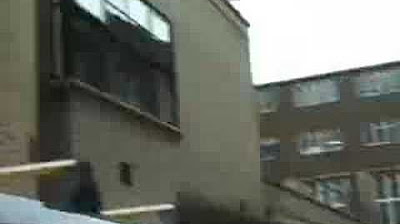Marie Curie and Spooky Rays: Crash Course History of Science #31
TLDRThis script recounts the groundbreaking era of late 1800s and early 1900s in physics, highlighting the discovery of radioactivity and the pioneering work of Marie Skłodowska Curie. It details the serendipitous discovery of X-rays by Wilhelm Röntgen and Antoine Henri Becquerel's subsequent research into uranium's spontaneous radiation. The narrative then focuses on Curie's significant contributions to understanding radioactivity, her Nobel Prize achievements, and her legacy in both scientific discovery and medical applications. The script also briefly mentions other notable women in early 1900s science, emphasizing the Curie family's impact on physics.
Takeaways
- 🏆 Marie Curie was the first woman to win a Nobel Prize, the first person to win two, and remains the only person to win in two different fields of natural science.
- 💡 The late 1800s and early 1900s marked a revolution in understanding the fundamental nature of matter, with the discovery of radioactivity and the birth of particle physics.
- 🌌 Wilhelm Röntgen discovered X-rays, which are a form of electromagnetic radiation that can penetrate different materials and reveal internal structures like bones.
- 📸 Röntgen's work with X-rays led to the first Nobel Prize in Physics in 1901 and the development of radiology for medical imaging.
- 🔬 Antoine Henri Becquerel discovered that uranium could emit rays that affected photographic plates, leading to the concept of radioactivity.
- ⚛️ Becquerel's research showed that radiation could have different charges and that uranium's rays could be deflected by electromagnetism, distinguishing them from X-rays.
- 🧪 Marie Curie conducted experiments that demonstrated radioactivity was a property of the atom itself, challenging the previously held belief in the indivisibility of atoms.
- 🏛️ Curie's work with radioactivity took place in a shed, where she unknowingly exposed herself to the dangers of unventilated radioactive materials.
- 🏵️ Marie and Pierre Curie discovered the radioactive elements polonium and radium, with the latter being used in the treatment of cancer.
- 🎓 The Curies, along with Becquerel, were awarded the Nobel Prize in Physics in 1903 for their work on spontaneous radioactivity.
- ⚰️ Marie Curie's dedication to science ultimately led to her death from cancer, but her legacy and contributions to science are enduring.
Q & A
What significant revolution in the understanding of matter occurred during the late 1800s and early 1900s?
-The late 1800s and early 1900s witnessed a revolution in the understanding of matter with the discovery of radioactivity, marking the birth of particle physics.
Who was the first woman to win a Nobel Prize, and what is her unique achievement regarding Nobel Prizes?
-Marie Skłodowska Curie was the first woman to win a Nobel Prize. She is also the only person to win Nobels in two different fields and one of only four people to win in multiple natural sciences.
What phenomenon did Wilhelm Röntgen discover, and how were these rays initially referred to?
-Wilhelm Röntgen discovered X-rays, initially referred to as 'spooky rays', which later became known as 'Röntgen rays' after him.
What was the significance of Antoine Henri Becquerel's work on uranium and its relation to X-rays?
-Antoine Henri Becquerel discovered that uranium naturally emitted rays that could affect photographic plates, which was a form of radiation different from X-rays and led to the concept of radioactivity.
What medical application did Röntgen's discovery of X-rays lead to, and how did the Curies contribute to it?
-Röntgen's discovery of X-rays led to the use of radiation for medical imaging. The Curies expanded on this by using radioactive materials to treat cancer and developing techniques for isolating radioactive isotopes.
What was the impact of Marie Curie's discovery of radioactivity on the scientific understanding of atoms?
-Marie Curie's discovery of radioactivity challenged the long-standing belief in the immutability of atoms, proving that atoms could decay and release energy, thus splitting the atom.
What was the significance of Marie Curie's work in the context of women in science during her time?
-Marie Curie's achievements were groundbreaking, as she became the first female professor at the Sorbonne and was recognized for her own scientific contributions, not just as an assistant to her husband.
What was the contribution of Becquerel's research to the understanding of the properties of radiation?
-Becquerel's research contributed to the understanding that radiation can have electrically negative, positive, or neutral charge, and that uranium emits rays that can be deflected by electromagnetism.
How did Marie Curie's work environment during her early research affect her health?
-Marie Curie conducted her early research in an unventilated shed, unaware of the dangers of handling radioactive substances, which eventually led to her death from cancer.
What legacy did the Curie family leave in the field of science, and how was it recognized?
-The Curie family, including Marie Curie, her husband Pierre, and their daughter Irène Joliot-Curie, all made significant contributions to science, with multiple Nobel Prizes awarded to them, and Marie being the first woman to be entombed in Paris's Panthéon for her achievements.
What other notable female scientists from the early 1900s are mentioned in the script, and what were their contributions?
-The script mentions Alice Ball, who developed a treatment for leprosy, and Gerty Cori, who discovered the Cori cycle, winning the Nobel Prize in 1947.
Outlines
🔬 Pioneering Discoveries of Radioactivity and Marie Curie's Legacy
This paragraph introduces the groundbreaking era of late 1800s and early 1900s in physics, focusing on the discovery of radioactivity and the immense contributions of Marie Curie. It sets the stage with the historical context of physics, mentioning Newton's laws, thermodynamics, and electromagnetism. The narrative then shifts to Wilhelm Röntgen's accidental discovery of X-rays, leading to his Nobel Prize and the establishment of radiology. Antoine Henri Becquerel's experiments with uranium and his observations on natural radiation are highlighted, which laid the foundation for understanding radioactivity. The paragraph concludes with Becquerel's medical insights into the potential of radioactive substances to combat cancer, foreshadowing Marie Curie's entrance into the scientific arena.
🎓 Marie Curie's Journey and Revolutionary Contributions to Science
This paragraph details Marie Curie's early life, educational background, and her path to scientific prominence. Despite the challenges of being a woman in a male-dominated field, she pursued her education in Paris, excelling in physics and mathematics. Her initial struggles with poverty and language did not deter her from achieving academic excellence. The narrative then delves into her professional life, her marriage to Pierre Curie, and their collaborative scientific endeavors. Marie's innovative theory of radioactivity, which challenged the prevailing notion of the atom's indivisibility, is emphasized. The paragraph also chronicles the Curies' discoveries of polonium and radium, their Nobel Prize win, and their application of radioactive materials in cancer treatment. The story of Marie Curie's life concludes with her untimely death due to cancer, a testament to her dedication to science, and her posthumous recognition in the Panthéon.
🌟 Celebrating Women in Science and a Glimpse into the Future
The final paragraph shifts focus to recognizing the achievements of other women in science during the early 1900s, such as Alice Ball and Gerty Cori, who made significant contributions to their respective fields. It also mentions Irène Joliot-Curie, Marie's daughter, who continued the family's legacy by winning a Nobel Prize. The paragraph serves as a tribute to these trailblazing women and their impact on science. The narrative then transitions to hint at the upcoming topic of modern physics and the pivotal role of Albert Einstein, setting the stage for the next episode in the series.
Mindmap
Keywords
💡Radioactivity
💡Marie Skłodowska Curie
💡Wilhelm Röntgen
💡Antoine Henri Becquerel
💡Nobel Prize
💡X-rays
💡Electromagnetism
💡Radioactive decay
💡Thorium
💡Polonium
💡Radium
Highlights
Marie Curie was the first woman to win a Nobel Prize, the first person to win two, and the only person to win in two different fields.
Wilhelm Röntgen discovered X-rays, which led to the first Nobel Prize in Physics in 1901.
Antoine Henri Becquerel discovered that uranium emitted rays that could be deflected by electromagnetism, different from X-rays.
Becquerel's research indicated that radiation could have electrically negative, positive, or neutral charge.
Marie Curie formulated a theory of radioactivity, suggesting atoms themselves break down and release energy.
Curie's theory challenged the immutability of atoms, leading to the understanding that atoms could be split.
Marie and Pierre Curie discovered the radioactive element polonium, named after Marie's homeland.
The Curies also isolated radium from uranium ore, contributing to the understanding of radioactive isotopes.
The Curies shared the 1903 Nobel Prize with Becquerel for their work on radioactivity.
Marie Curie applied her theory to develop treatments using radioactive materials for cancer.
During World War I, Curie set up mobile radiography units to aid in the treatment of soldiers.
Marie Curie's work was conducted in an unventilated shed, unaware of the dangers of radioactive substances.
Marie Curie died of cancer in 1934, likely due to her exposure to radioactive materials.
In 1995, Marie Curie was posthumously honored as the first woman to be entombed in Paris’s Panthéon for her scientific achievements.
Other notable women scientists of the early 1900s include Alice Ball and Gerty Cori, who made significant contributions to their fields.
The Curie family has three Nobel laureates, including Marie Curie, Pierre Curie, and their daughter Irène Joliot-Curie.
Transcripts
Browse More Related Video

The Discovery of Atomic Structure (Chemistry & Physics) - [1-2-5]

radioactivity explained

Rutherford and the Old Cavendish Laboratory at Cambridge

The World Of Enrico Fermi (1970)

Atom: The Key To The Cosmos (Jim Al-Khalili) | Science Documentary | Reel Truth Science

Nobel Prize Lecture: A Synthesis for Quantum Dots Leads to a Nano-World of Opportunities
5.0 / 5 (0 votes)
Thanks for rating: